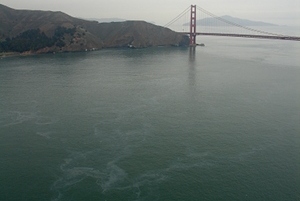 Oil on the surface of the San Francisco Bay in November 2007. Photo: NOAA.
Oil on the surface of the San Francisco Bay in November 2007. Photo: NOAA.
We have no idea how much oil gushed out of BP’s Deepwater Horizon well into the Gulf of Mexico—estimates vary from 92 million gallons to over 320 million gallons, according to the NewsHour’s widget. By comparison, a much smaller amount of oil—53,000 gallons—was spilled into San Francisco Bay when the container ship Cosco Busan ripped its hull open on the Bay Bridge in November 2007. The volume of oil spilled in the Gulf is several thousand times what was spilled in San Francisco Bay, and obviously the environmental consequences of the Gulf spill will far exceed what we’ve seen here. But the ecological studies conducted in the wake of the Cosco Busan spill give us an idea of what we can expect in the Gulf.
After the Cosco Busan spill, scientists looked at the effects of oil on different coastal habitats, and on individual species. A year after the spill, the QUEST radio story Oil Spill Anniversary discussed a study that revealed the negative effects of oil on Herring embryo development. Other studies looked at the impact of oil on intertidal areas, eelgrass beds, native oysters, Brown Pelicans, Marbled Murrelets, and more—a full list of studies that assessed damage to natural resources is at this NOAA site (click on “Case Documents” on the right to download the list as a PDF). Not all organisms fared poorly; the snowy plover, a bird that lives on beaches and is already a threatened species, was fine. They build their nests far enough from the water to be buffered from oil contamination.
Research about impacts and restoration in the Gulf is just getting started. The official US government website about the oil spill switched from a mindset of emergency response to one of restoration, reflecting the huge challenge that lies ahead—provided the oil doesn’t start flowing again. Some government agencies, like the EPA, are sharing the data that is being collected as you read this. My hope is that these research efforts will involve extensive long-term monitoring; the effects of oil spills can last for decades, and we need to understand how ecosystems function over time, with and without oil. We have the opportunity to learn a lot from this disaster, and hopefully we’ll have the money to fund it. The company that operated the Cosco Busan was fined $10 million, $2 million of which is slated for environmental efforts. If BP is fined in proportion to the volume of oil spilled, billions could go towards ecological research.
37.804556 -122.3711
